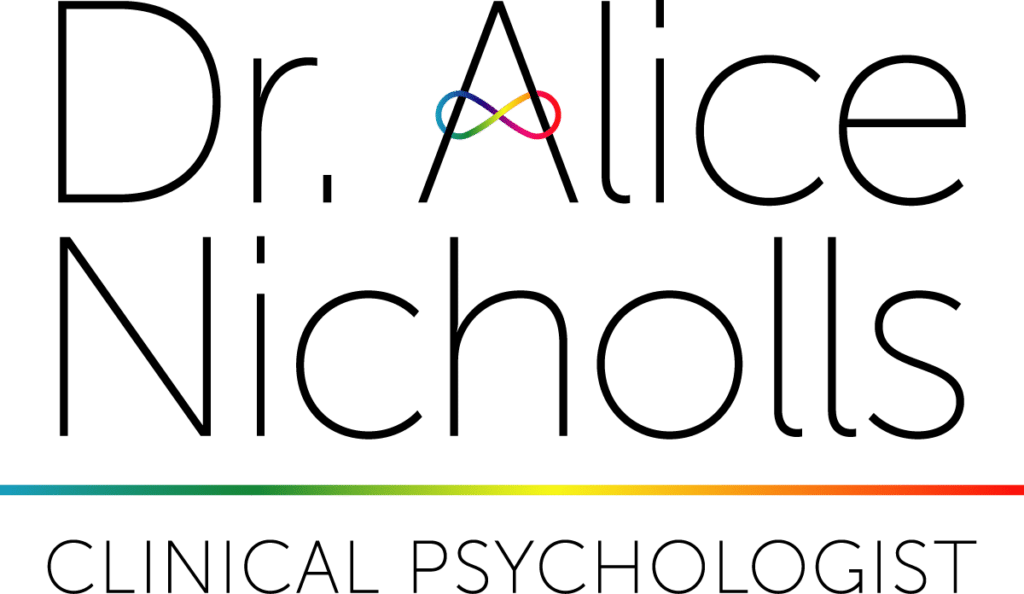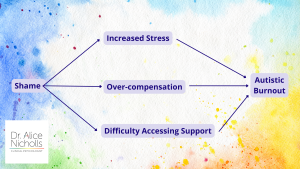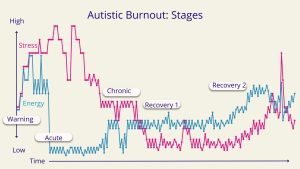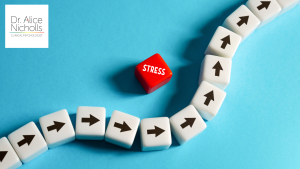During my years of working with hundreds of late-realised, high-masking Autistic Adults in Autistic Burnout I’ve noticed shame as a common theme in the factors contributing to, and maintaining their Autistic Burnout.
In this article I will outline:
- What shame is
- Sources of shame for Autistic people
- How shame can contribute to the causes of Autistic Burnout
- How shame can prevent recovery from Autistic Burnout
- What you can do about it.
What Shame is
Shame is a social emotion, so it’s something that we feel due to our relationships with other people.
It happens when we perceive that there is something about us that other people wouldn’t like or would cause them to exclude us.
We might feel shame about something we have done that we believe was wrong, but often it is because we fear other people don’t or won’t like something about us.
This is often based on real life experience of being criticised, bullied, abused or excluded for being different, not fitting in or behaving as others expect us to.
It’s associated with thoughts such as I’m not good enough, I’m selfish, lazy or fundamentally flawed as a person.
We tend to believe, at least on some level, that the way we fear other people will perceive us, is true.
It causes us to want to hide the aspects of ourselves that we think other people wouldn’t like.
Our prehistoric, hunter gatherer ancestors survived by living in groups, because it enabled sharing skills and resources.
To be left out of the group, to be disowned, was a threat to our survival.
In theory this made shame an adaptive emotions. We evolved to have it because it increased our chances of survival.
In small hunter gatherer communities we would have been trying to fit in with a small group of people but in our modern way of living, where we are potentially connecting with thousands of different people we are now at risk of being excluded from a massive number of groups.
We don’t need to be liked or included by everyone we meet, but our old brain doesn’t know this. We’ve still got a pre-historic brain that perceives all social exclusion as a threat to our survival.
Please don’t get me wrong, sometimes social exclusion is a threat to our survival. But my point is that it is not always a threat to our survival, and our brains don’t know the difference.
Sources of Shame for Autistic People
As Autistic people we are likely to experience shame whenever we feel the risk of social exclusion.
This can be subtle, so it can be anything you fear makes you less likeable, less successful, less desirable.
Unfortunately there are lots of sources of shame for Autistic people.
Stigma around autism is still a massive problem, A recent study (Riebel et al 2025) found that 45% a large sample of Autistic Adults scored highly for self-stigma.
We are living in a capitalist and ableist society where there is a widely accepted narrative that we all have to contribute to society and that money is only way a person can make a meaningful contribution.
Even if we, ourselves, don’t agree or can see many ways people make a contribution to the world beyond money we may still internalise these cultural messages and feel like we are less worthy, likeable or desirable.
During your childhood, and even now in the media you were likely exposed to problematic ideas and images about Autistic people.
I mostly work with late realised autistics who normally have at least one Autistic parent who probably never knew they were autistic, but spent their lifetime being ashamed of their own difficulties and massively compensating for them.
Shame can get passed down the generations like this. Parents who spent their lifetime, probably not realising they were autistic but hiding their differences for fear of being socially excluded. When these people went on to have a child who wanted to stim, or wasn’t following the neurotypical social rules it would have created a threat response in the parent. This is likely to have made them become harsh, critical parents.
The various narratives around Autism viewing it as a problem to be cured or a tragedy can make it feel shameful just to be autistic.
The anti-diagnosis argument, suggesting that autism doesn’t exist, or we shouldn’t want to be associated with it can make us feel ashamed for being different, for not understanding why and for wanting a diagnosis.
You will have come across intolerance of difference and may have had traumatic interpersonal experiences such as abuse, bullying or exclusion.
And of course there are difficult social encounters where there is a between-neurotype communication issue that has, in the past been framed as the fault of the Autism, rather than a communication- between-neurotype problem (The Double Empathy Problem, Milton 2012).
These experiences all contribute to shame, making us think we need to hide our autistic characteristics and our identity as an Autistic person.
How Shame can Contribute to the Causes of Autistic Burnout
Shame contributes to Autistic Burnout in several ways:
Autistic Burnout is the result of too much stress with too little opportunity for recovery and support for too long.
Shame can:
- Increase stress levels
- Motivate us to over-compensate
- Block opportunities for recovery and support
Increased Stress
Just feeling ashamed increases our stress levels, before we start to do anything about it. Our threat system goes online, it produces cortisol and we have that ‘fight, flight, freeze, faun’ response.
We might find ourselves arguing that we didn’t do something, or that something isn’t true.
We may avoid or escape situations where we fear our shameful characteristics will be exposed.
We might feel frozen, unable to act or do anything.
And we might faun, ignore our own needs, agree with the people around us, do as we are told or act to appease people.
Over-compensation
Shame can also contribute to our stress levels by motivating us to hide whatever we are ashamed of by over-compensating for it.
We can de-activate our threat system to some extent by taking action or doing something about the threat.
In the short term this makes us feel better, our cortisol levels decrease and our dopamine levels increase.
This mechanism is really helpful if the threat is something we can do something about and then the threat goes away.
For example if the threat is your home being broken into so you move into a drive state to increase your home security and achieve this. the threat you were trying to escape is now reduced and you are more able to relax.
But what if that threat is threat that we will be perceived as selfish, lazy or robotic? or that underneath it all we really are selfish or robotic what then?
We might push ourselves to work harder and longer, or to monitor our facial expression, make more eye contact, ask more questions.
We might over compensate by pushing ourselves even harder to appear to be the opposite of whatever the feared criticism is.
For example we might try to appear hyper-social, or take on the role of therapist within our friendship group.
We might try to appear to be a team player at work by making cakes for everyone and taking responsibility for organising birthday cards.
The problem is that when we are talking about shame, doing things doesn’t resolve the underlying issue.
The moment you stop working harder and longer, Or forcing yourself to mask or overcompensate, you go back to feeling ashamed
So we keep looping between threat and ‘doing‘ states. Which both maintains our sense of shame and increases our list of things to do leading to overwhelm and exhaustion.
Preventing Support and Recovery
While we are stuck in threat, or a threat-doing loop our ability to rest, recover and recuperate is impaired or blocked.
The things that might help us to replenish some of that energy are largely inaccessible to us.
We might be ashamed of our need to have time alone, to engage in our special interests, to work without interruptions. We might feel unable to meet our sensory needs and ashamed of even having them.
Also, even if we do stop to think it might be useful to rest or regulate, shame can make us think we can’t afford to take a break, that we will be in danger if we stop over-compensating, that we haven’t done enough to deserve a rest or that we shouldn’t need a rest.
Our society often normalises or even idealises being busy, being stressed and I often hear people tell me, well everyone is stressed, life is hard, everyone just gets on with it, so why can’t I?
There is shame associated with needing a break, needing to rest, and meeting our needs.
How Shame can Prevent Recovery from Autistic Burnout
When I work with people in Autistic Burnout using Authenticity: The approach we focus on three core elements:
- Acceptance
- Accommodation
- Aspiration
Acceptance
By acceptance I mean acknowledging and accepting your history, your strengths and needs.
During this phase of Authenticity we focus on identifying what you already know about what you need, what makes you feel better and worse and work towards identifying and accepting your individual needs.
Shame is often a big barrier here as people are still fighting against the idea that they find some things stressful or difficult.
It is very hard to start meeting needs if you are too ashamed to acknowledge you have them in the first place.
Accommodation
Accommodating your needs is a pivotal part of reducing your stress and risk of Autistic Burnout.
We look at ways you can accommodate your basic and sensory needs so that you can stay regulated.
We identify how you can make social demands more manageable and how you can budget your energy levels so that you start to build up some reserves again.
We look at adjustments you might benefit from at home, work and when accessing services.
Shame can be a barrier here, where people are feeling the need to overcompensate, where they don’t feel able to ask for accommodations, or to appear different, for example, by meeting their sensory needs by stimming or using stimulation reducing aides.
Aspiration
Aspiration is the final pillar in the authenticity approach.
Aspiring is about more than surviving, its about, once your needs are met, starting to live a life that you actually enjoy.
We look at your identity, who you are with and without the Autistic Burnout, what is really important to you and what you can let go of or do less of.
Shame often comes up again here as a barrier, where you might have just about accepted you have needs and dealt with some of the shame around that, dealing with the shame around having different preferences and actually embracing your identity is a whole new level.
What you can do about Shame
Before you start addressing shame it is really important to acknowledge that this is an understandable reaction to your life experiences so far.
Autistic people do experience stigma and social exclusion, this is not something that has come out of nowhere.
The shame response has developed, on some level, to keep us safe. The fact that it has developed is a symptom of a wider societal problem, not you specifically.
As a society we need to do a lot of work on reducing stigma around Autism, disability and difference in general.
Please check on your safety.
Sometimes people are continuing to do more than they have capacity for because it is just not safe for them to stop. Sometimes people are in situations where to meet their needs would put them at greater risk from someone or something else.
There may be an abusive person, relationship or an unhelpful environment in your life that you might need help to manage, to escape, to limit or enforce boundaries with before you can be and feel safe.
There are several things you can do to start addressing shame, I have put these in an approximate order in terms of their difficulty and how accessible they are at different stages of recovery, starting with the easiest/most accessible first:
- Reduce threat response
- Increase self-compassion
- Share with safe people
- Identify and address shameful beliefs about self
- Identify and address overcompensation
Reduce threat response
I like to think of reducing a threat response as a slow winding down of the threat response.
Doing anything that helps to calm you, that soothes or relaxes you or makes you feel cared for or supported will activate your soothing system which has an inhibitory effect on the threat system and will help to de-activate your threat system.
If you have been in a threat state for a long time, you may find it very difficult to access the soothing system, so please don’t worry if this is something you struggle to access straight away.
You might find it easier to find things that make you feel slightly calmer, slightly more rested or slightly more supported. Please don’t aim for perfection here.
Connecting with others who we feel safe with will also activate the soothing system. Shame can be a massive block to connection. If we are afraid people won’t like us for who we are and we have to hide who we are, then we can’t actually connect with anyone.
If there are people in your life who you feel safe to be authentically you with then these relationships can be a source of soothing and support.
It might be that you feel able to connect with people over a shared interest, experience or hobby. You don’t need to be sharing your deepest darkest fears with people to feel increased connection.
Animals and nature can also be a source of connection that is often overlooked (I’ve written more about low-demand connection here).
If you are really struggling to think of anyone who you can connect with, even over a safe topic then you might find it helpful to join some Facebook groups for Autistic people, to listen to podcasts by autistic people or to join groups focusing on a hobby or interest that you have.
The way you experience connection does not have to conform to neurotypical standards.
Increase self-compassion
Increasing self-compassion isn’t a quick fix, it is something that you may need to work on for a long time.
One of the first blocks to being more compassionate is the fear that it means being ‘soft’ on yourself.
Compassion is defined by Prof. Paul Gilbert and the Compassionate Mind Foundation as:
“A sensitivity to suffering in self and others with a commitment to try to alleviate and prevent it”.
This does not necessarily mean being soft on yourself… although sometimes that is what it means….You can be compassionate towards yourself and do something that you don’t want to do but know is going to be good for you.
You can also be compassionate towards yourself and chose to allow yourself to rest if that is what you need.
In this sense compassion is wise, kind and strong.
If you have spent your whole life motivating yourself with self-criticism you won’t be able to simply switch it off and switch on self compassion. We don’t want a situation where you are criticing yourself for being self-critical. You are doing the best you can given your life experiences and resources available to you and this will take time and practice.
Even if you have not had much practice at being compassionate towards yourself in the past you will probably have either felt compassion for someone else or experienced someone else treating you with compassion.
These are useful experiences to draw on.
If you’ve cared for a child, a pet, a friend, a family member and felt that pull to help them, to relieve their suffering then you can try to replicate that with the way you treat yourself.
There is a powerful passage in the book ‘how to keep house while drowning’ where KC Davis asks the reader: Do all humans deserve to be cared for? and ‘Are you a human’ She writes about an experience where she adopted a stray cat from a rescue centre. the cat was feral and under nourished and (to begin with) she had no relationship with it but she chose to care for it and in the same way, you can chose to care for yourself.
If you have had the experience of receiving compassion from someone else, a family member, a teacher, a friend or therapist, you can also think about how they treated you when they were acting with compassion and think about how you could replicate this experience.
Some people find it helpful to add and that’s okay to soften statements about what they can’t do, for example ‘I can’t think straight… and that’s okay‘ or ‘I can’t face going out today…and that’s okay.’
Share with safe people
Because of the social nature of shame and its motivation to hide, when we are actually safe to share our struggles and our differences and we feel heard and accepted it makes a massive difference.
If you have someone you feel safe to share with or a therapist then this is a something to experiment with doing more of with them.
But if you don’t have someone you feel able to share safely with then Identifying safe people and quite how much to share can be daunting.
I would suggest starting small and with low-risk information. You can even make it a question or start a conversation, for example asking … Do you find it hard to work in here when it’s noisy?
If you don’t feel ready then it might be worth listening to podcasts or reading blogs or books by Autistic people, seeing or listening to other people share can begin to make us feel less alone and more able to share.
I’m a big fan of online support communities and I have my own inside both Authenticity: The Course and Community and Basecamp, but there are also free ones on Facebook and discord. What I like about these is that you get a chance to see what other people are sharing and how they are getting reacted to before you start sharing.
Sometimes just seeing other people sharing experiences similar to your own and being responded to with acceptance and compassion is enough.
Identify and address shameful beliefs about yourself
Actually examining our shameful beliefs about ourselves can be quite confronting and distressing. I would suggest you wait until you are feeling relatively well before deep diving into this and perhaps, if it still feels very upsetting, doing it with the support of a therapist.
You will likely have some difficult beliefs or fears about Autistic people and about yourself.
This might be because of your early experience of Autistic people and the reactions of the people around you to other Autistic People.
It might be informed by the media representations of Autism you have been exposed to.
It might also be the criticism you received growing up, even if it wasn’t intended as criticism.
For example you might have been called sensitive, fussy or lazy.
you might have feared other people experienced you as robotic or unempathic.
You might fear that deep down you are rigid and controlling.
In the first instance, just acknowledging that you hold these beliefs or fears about yourself can help you to start to realise how much of your behaviour is motivated by shame.
Identify and address overcompensation
The way in which we compensate depends on the feared characteristic.
If you imagine what the opposite of your feared characteristic would be, you might find that your behaviour is being motivated by over compensation.
For example if you feared you would be perceived as ‘rigid and controlling‘. you might try to appear ‘flexible and easy going‘. You might do this by pretending not to mind when plans change, despite it causing you anxiety, letting other people make decisions, or even having a pre-planned list of ideas so you can appear spontaneous.
If you are worried you might be perceived as arrogant you might try to appear humble. You might do this by pretending not to know answers to questions, not correcting people even when you know they are wrong or making self depreciating comments.
Identifying how you might be overcompensating, in very specific terms, puts you in a position to decide whether or not you want to continue overcompensating in this way.
It might help to consider these questions:
- Is it essential to your survival?
- Is it essential for living in line with your values?
- Is it essential to a goal you have prioritised?
- Are you applying neurotypical standards to yourself?
- Are you trying to fit in with a group of people who wouldn’t like you otherwise?
- Are you trying to be liked by everyone?
- What would happen if you didn’t do it?
- What would be the benefits of not doing it?
If you know you need to maintain one of your compensatory strategies for your survival or another important reason, it doesn’t have to be based on shame.
You can decide, out of self-compassion that you would like to keep yourself safe in an unsafe situation and chose to act in a way which will keep you safe.
The key difference here is realising it is not because you are fundamentally flawed as a human being, but rather you are keeping yourself safe in a situation that is not ideal.
Be aware of that need to be liked by everyone, as we discussed earlier, your old brain thinks its important to your survival, but it simply isn’t possible to be liked by everyone and be true to yourself and it often isn’t essential to your survival in modern times.
Thinking about what would happen if you didn’t do it? can help you to assess whether it is essential and make a decision regarding whether this is something you would ike to keep doing or not.
If you have identified that you are overcompensating and don’t need to to maintain your safety then you can start to think about how you might slowly wind that down. I would go slowly here and aim to address one thing at at time as you feel able to.
Summary
Shame has evolved to protect us from being abandoned by others this was really adaptive for our pre-historic ancestors who would have needed to be included in the group in order to survive.
Shame activates our threat system as if being an outsider is dangerous to our existence. In modern living, being different or an outsider isn’t always dangerous to our existence.
Our society arbitrarily favours neurotypical attributes and forms of communication and we may have internalised some of this favouring as shame.
Shame contributes to our stress levels and prevents us from accessing support, putting us at greater risk of Autistic Burnout.
Shame can prolong episodes of Autistic Burnout by preventing us from accepting and accommodating our needs and building a more sustainable life.
You can decrease feelings of shame by being and feeling safe, winding down your threat response with soothing activities, increasing self compassion, sharing with safe people and addressing over compensation.
Further Reading
(Amazon affiliate links)
- Unmasking Autism by Dr. Devon Price
- How to Keep House While Drowning by KC Davis
- The Compassionate Mind by Paul Gilbert
I am an Autistic Clinical Psychologist specialising in Autistic Burnout if you would like to know more about my work please check out my:
- Mailing list community for people who want to receive helpful information and resources about Autistic Burnout.
- Free short course on How to Break the Cycle of Autistic Burnout (link goes straight to registration page)
- Authenticity Basecamp: A 90 day support programme for people in the early stages of recovering from Autistic Burnout who want to get calmer, clearer and more supported.
- Authenticity: The Course and Community: For late-realised, high-masking Autistic adults who want to build more sustainable, authentic lives and break free of the cycle of Autistic Burnout for good.











